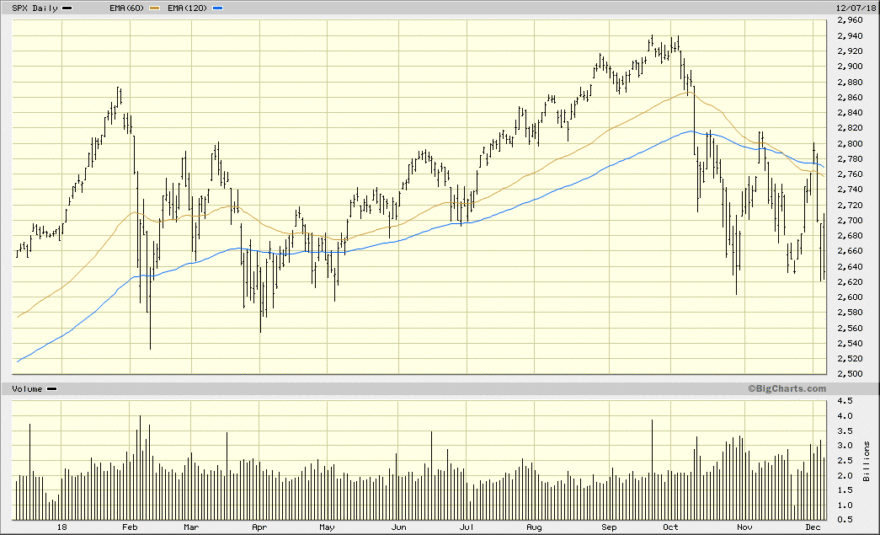There has been a lot of talk recently about a recession, with concerns about slowing economic growth, the Federal Reserve cutting interest rates, an inverted yield curve, a trade war with China, and so on. A recession is two or more quarters of economic contraction, of negative growth of a country’s economy. Several European countries recently reported one quarter of negative growth and may well be on their way towards a recession this quarter.
So… will there be a recession in the US? Yes, there will. When? I have no idea.
Please excuse my glib answer. I could put a lot of thought and analysis into the question, but statistically, it’s not predictable with accuracy or certainty. Recessions are an inevitable part of the economic cycle, winter to the summer season of expansion. Unfortunately, unlike December 22, the first day of winter, it is not possible to determine when the first day of a recession will occur. Economists only calculate recessions in hindsight and it would be foolish, and likely even detrimental, for investors to try to change their investments based on today’s recession fears.
While the US Stock Market made new highs in July, August saw a pullback with increasing worries about a recession. A recession would be negative for investors in the short run, but I think it is very important for investors to stay focused on the long run. The temptation is to think that if we could go to cash before a recession that our returns would be better and we’d avoid losses. As appealing and rational as those thoughts may be, the reality is that attempting to time the market is exceedingly difficult. In my experience, investors who try to time the market rarely do better than those who remain invested and they often would have been better off making no changes.
Thankfully, I don’t think you need a crystal ball to be a successful investor. Let’s keep a healthy perspective on recessions. Here are some thoughts which may help you to stay invested.
1. If you’re a young investor, contributing monthly to your 401(k) or IRA, and have three or four decades before you retire, you should want a recession! That’s the stock market throwing you a fire sale. You get to buy shares when they are down maybe 20% or more! While Dollar Cost Averaging cannot guarantee a profit, I can tell you that the shares of mutual funds which your colleagues bought in 2008 or 2001 have probably been enormously profitable. If you bought an S&P 500 Index fund 10 years ago, you’d be up about 320% today.
Recessions have occurred every 5-10 years since 1900. If you are investing for many decades, I wouldn’t be worried about what happens in 2019 or 2020. If the market goes down, keep buying shares of a diversified asset allocation and be glad to buy shares with a very low cost basis.
Do, however, avoid betting heavily on an individual stock. While the overall stock market has recovered very nicely from previous recessions, there can always be individual companies like Lehman Brothers or Enron, which don’t survive. Those companies may be present in an Index Fund, but if your fund owns 500 or 1000 companies, the impact of one company blowing up is often inconsequential.
2. Think in percentages, not dollars, and study stock market history. A 20%+ drop in the market does occur from time to time, maybe even two or more times a decade. Knowing this, you should be prepared for a drop of this magnitude if you’re in an aggressive allocation. But let’s rephrase this in dollar terms: once you have a $500,000 portfolio, could you stomach a drop of $100,000? That sounds a lot worse than a 20% drop! Of course, when the market goes up 20%, like it did from December 2018 to the highs of July, that would also be a $100,000 gain.
Seeing performance in dollar terms may feel harsher than looking at performance as percentages which fluctuate greatly from year to year. When you have a big account, you are going to see big swings. This can be difficult to get used to and that’s why I want to look at percentages instead.
If you understand that a market cycle includes up and down years, you will understand that a drop is often only temporary until the market rebounds. If you sell when the market is down and go to cash, you are locking in that loss and eliminating the possibility of participating in a future up cycle. While there’s no guarantee this cycle will always occur in the future, it has been the historical pattern, and I think you have to embrace this tenet of investing if you are to be successful over time.
3. We build highly diversified portfolios and rebalance. If your target allocation is 60% stocks and 40% bonds (60/40) and the market drops, your weighting to stocks decreases. We will sell some bonds and buy stocks that are down. We have a built-in mechanism to respond to market fluctuations already. Just by maintaining a target allocation and rebalancing, we will be buying stocks when they are on sale and trimming stocks when they have run up. That won’t prevent a loss when the market does drop, but rebalancing can help to potentially smooth returns and maintain your target level of risk for your portfolio.
4. Investors who are getting closer to retirement undoubtedly feel the most pressure about near-term performance. In part, this is due to an oversimplification of the retirement planning process, by using something like the “4% rule”. Then, if your portfolio drops 20% in the year before retirement, it would appear to be devastating. If you were expecting $40,000 a year in income from a $1 million portfolio, a drop to $800,000 would reduce your 4% withdrawal rate to just $32,000 a year.
That’s why we should be careful about using a “rule of thumb” approach as being the ultimate guide in retirement planning. For someone who is 65 and healthy, we should be planning for a 20-30 year time horizon, not for the next 1-2 years. As retirements become longer, it is a reality that you are going to experience multiple recessions. Looking at a retirement date of 1-3 years away does not mean that you automatically have a short-term investment horizon. We need to think long-term and have a plan that isn’t going to be derailed by performance in the last year or two before retirement.
5. If you’re retired and taking 4% withdrawals, consider this: The dividends in our US stock market ETFs are around 2% and higher for our foreign ETFs, often in the 3% range. Even with today’s low interest rates, your bonds are overall yielding 2% or more. Regardless of your allocation, you’ve already covered at least half of your annual 4% withdrawals from stock dividends and bond interest. In terms of sales, you might be dipping into principal by only 2% a year or less. If the market is down for a year or two, you’re not going to run out of money. For my clients who are taking distributions, we set dividends and interest to pay out in cash and I generally only have to sell a small number of shares once a year.
I’m not looking forward to a recession or a Bear Market, but I’m not really all that worried either. Knowing that recessions are a natural part of the economic cycle doesn’t make them any less painful, but if you can step back and take a longer-term view, you will be more comfortable with accepting that being an investor requires patience, perseverance, and a positive attitude. We’ve built our portfolios for all environments, but that doesn’t mean that risk can be avoided or eliminated. Rather, we can choose how much risk we take and to avoid unnecessary risks of being overweight one stock, sector/country funds, or being undiversified. Whether you are a new investor or a retiree, I don’t want you to make knee-jerk reactions because of talk about a future recession. Recession talk may play well on cable news, but it’s not a useful input for long-term investment success.





